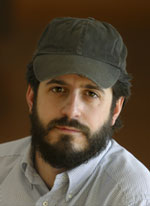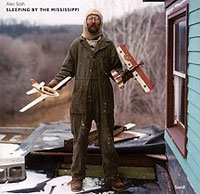 |
→ February 2006 Contents → Feature
|
Alec Soth's Niagara
|
 |
||||||
|
The past two years have been very interesting for photographer Alec Soth, a period of time in which he has gone from being an unknown to fame after his exceptional book Sleeping by the Mississippi was released in 2004. An invitation to join the famous photo agency Magnum as a nominee soon followed and helped put his name on the map in photojournalism circles. In 2005 he was short-listed for the prestigious 2006 Deutsche Börse Photography Prize, to be announced on March 22, 2006. (Read the September 2004 Q&A with Alec Soth which previously appeared in The Digital Journalist.)
"You know, it's so different from the Mississippi work," Soth says. "I knew about the place from this old Marilyn Monroe movie called 'Niagara.'" Soth is referring to a 1953 Marilyn Monroe film co-starring Joseph Cotten, in which Monroe's character, Rose, and a secret lover hatch a plan to murder her mentally-unbalanced husband (Cotten) while honeymooning in Niagara Falls. Beginning in early 2004, Soth set out from his home in Minneapolis, Minn., making a total of seven trips of between two to three weeks in length to the area, working on both the U.S. and Canadian sides of Niagara Falls. "Before ever having been there I liked the place. I wanted to explore the scenes of love, and approach it with a kind of lyrical sensibility," says Soth. But what Soth found was much more than he had bargained for. "After the fifth trip, I was done," he relates. "The Mississippi work was fun. But here I was having negative experiences. After the fifth trip it was hard to go back." Soth says that as the work progressed it became like a downward spiral, and became darker and darker in tone. "There's this one guy named David. He may not be in the book ... his girl committed suicide. He had this collection of love letters ... the letters were so raw." Soth said the work was becoming too dark. He had wanted to maintain the sense of melancholy without it becoming so intense. But it was becoming harder to do. "When I started this project I said to my wife 'this is dedicated to you.' But that all changed," he says jokingly. In a high-tech world where most photographers are using digital cameras, Soth remains firmly dedicated to keeping things simple. He works with a large 8x10-inch camera, the high-resolution negatives giving his prints an unparalleled clarity of detail that digital cameras have yet to equal.
"Digital technology is great, but this perpetual upgrading — I just want to use my Leica and Tri-X," he says. Soth is no Luddite. Two years ago he used a medium-format camera with a digital back on a project but decided that he did not like the look. So for now he continues working with large format film. Soth uses 8x10 cameras made by R.H. Phillips and Sons and K.B. Canham, and says he prefers the "simple elegance" of the Phillips. His lenses are heavy, large aperture ones "so that I can see what I am looking at" on the camera ground glass. His film of choice is Kodak Portra 400 NC. In this post-9/11 era of paranoia and suspicion in which photographers have found themselves being targeted by law enforcement types, Soth says he had few problems working with his imposing cameras. "I think the camera looks old-timey enough. With Niagara I had more problems photographing property than people. Sometimes I feel that people value property more than other people. I just encountered resistance a lot of the time," he says. On how he would describe his time in Magnum so far, Soth says, "It's complicated. I'm still figuring it out. The more I'm in New York, the more involved I feel. It's been challenging. It's a labyrinth ... it's a big organization. I've been so distracted by shooting and the gallery world, I'm still finding my way."
© Roger Richards
|
|||||||
Back to February 2006 Contents
|
|

